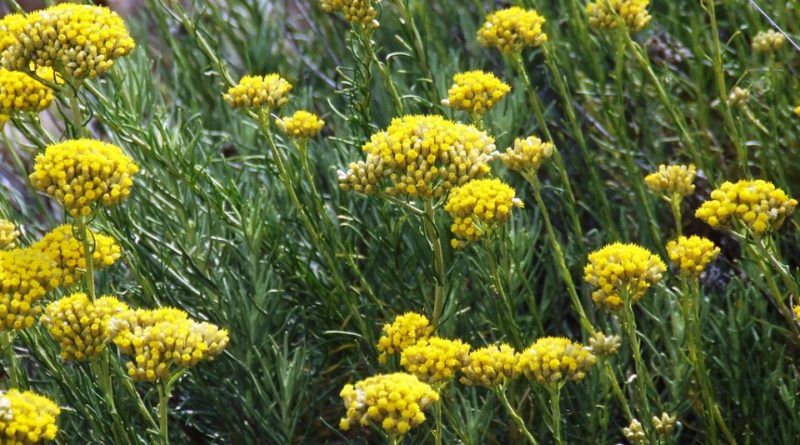Achillea ageratum
Achillea ageratum
The sweet yarrow (Achillea ageratum L.) is a herbaceous species belonging to the Asteraceae family.
Systematic –
From a systematic point of view, it belongs to the Eukaryota Domain, the Plantae Kingdom, the Spermatophyta Superdivision, the Magnoliophyta Division, the Magnoliopsida Class, the Asteridae Subclass, the Asterales Order, the Asteraceae Family, the Asteroidea Subfamily, the Anthemideae Tribe, the Matricariinae Subcrib and therefore to the Genus A. Agillea and .
The terms are synonymous:
– Achillea viscose Lam .;
– Conforata ageratum Fourr ..
Etymology –
The term Achillea of the genus was dedicated to Achilles (in Greek Aχιλλειοϛ Achilleios), mythical Greek hero who would have used some species of this genus to heal the wounds suffered in battle by his soldiers; a very ancient remedy so that this is one of the medicinal herbs found in an Iraqi necropolis of the Neanderthal man dating back to 60,000 years ago. The name Achillea was already present in the De simplicium medicamentorum facultatibus of the Greek physician Galen (129-200 AD).
The specific epithet ageratum comes from the name of the genus Ageratum, in turn coming from the Greek privative prefix α- a- without and from γῆρας géras old age: which does not age, because the flowers of some species of this genus last long even from buckets and as a transition from a generic name to a specific epithet due to a changed taxonomic order.
Geographical Distribution and Habitat –
Sweet yarrow is a typical plant of the western Mediterranean basin, present from Liguria to Spain and Algeria.
In Italy it is present in Liguria, Emilia-Romagna, Puglia and in all regions of central Italy including Sardinia.
Its habitat is that of rather humid uncultivated areas, at the edge of the ditches and along the roads, on mainly clayey soils, with optimum conditions in the Mediterranean area.
Description –
Achillea ageratum is a bushy perennial plant that has a short fusiform rhizome, dark on the outside, yellow on the inside.
This plant has erect, branchy or simple, slightly hairy stems, which are up to 60 cm tall.
The leaves are alternate, spatulate with roughly serrated edge, slightly whitish and gathered in axillary bundles, 3-5 cm long. Their surface is sprinkled with glandular punctuation and gives off a characteristic camphor smell, especially if wrinkled.
The yellow flowers of about 3 mm, all with short ligules that protrude just from the envelope, are grouped in very rich corymbs.
The flowering period is from April to October.
The fruit is a small oblong and flat achene with a truncated tip.
Cultivation –
Sweet yarrow, although it is a spontaneous Mediterranean plant, is cultivated in many places for its pleasant fragrance and, moreover, in small areas, it has naturalized outside its origin.
For its cultivation, however, it is possible to start from seed, considering that this plant prefers moist soils over mainly clayey soils.
Uses and Traditions –
The sweet yarrow plant was used in the Middle Ages to repel insects such as moths, lice and ticks and to spread a good smell in homes.
The plant also has analgesic, antipyretic properties, recognized since ancient times. The leaves, with a particular spicy-bitter taste, are sought after to flavor salads and soups.
Its inflorescences are popularly called “Perpetuini” because expertly dried they are used for delicious floral compositions.
Preparation method –
The leaves with a bitter taste can be used raw or cooked, added to salads or soups, but also chopped on fresh cheeses.
Guido Bissanti
Sources
– Acta Plantarum – Flora of the Italian Regions.
– Wikipedia, the free encyclopedia.
– Treben M., 2000. Health from the Lord’s Pharmacy, Tips and experiences with medicinal herbs, Ennsthaler Editore
– Pignatti S., 1982. Flora of Italy, Edagricole, Bologna.
– Conti F., Abbate G., Alessandrini A., Blasi C. (edited by), 2005. An annotated checklist of the Italian vascular flora, Palombi Editore.
Warning: Pharmaceutical applications and alimurgical uses are indicated for information purposes only, they do not in any way represent a medical prescription; therefore, no responsibility is accepted for their use for healing, aesthetic or food purposes.


